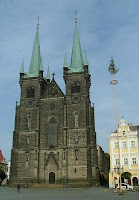
Just away from the main square’s highest corner, Chrudim’s crookedest and narrowest house leans across its crookedest and narrowest street. The façade of the house is dark and dusty and its heavy stone balconies are propped on leaning pillars like an old man who can’t stand without a cane.
It’s hard to imagine a more appropriate home for the National Museum of Puppets and Marionettes.
The first displays are in a back room on the ground floor. Puppets from as far as England, China, Japan and Indonesia are on display here, alongside a description of the basics of the puppeteer’s craft. The museum building dates from 1573 and has steep and narrow staircases, so this introductory room is an overview for anyone confined to a wheelchair or otherwise unable to navigate the building.
Having so many collections side by side makes it easy to appreciate the varying styles employed by the different craftsmen and artists. The Venetian masks and brilliant satins and velvets of the Romeo and Juliet costumes are worthy of any European theatre, while Cinderella and her sisters could be dolls from any little girl’s collection. The exaggerated colours and expressions from Otesanek (the Czech folk tale about the boy who ate the world) make those puppets look like they belong at a science fiction convention or a secret NASA base.
In the 18th and 19th centuries when puppet theatres started to perform in Czech they were often the only form of theatre in small towns and villages. Their presence helped to spread the use of the Czech language and reawaken interest in Czech culture and history, which had ebbed under the Germanization policies of the Austrian empire.
At the time “representatives of this folk art were put in the same class as tightrope walkers and bearleaders and scorned as vagabonds and beggars”. Puppets and marionettes now though are among the most sought after of Czech gifts and souvenirs and are excellent examples of local craftsmanship and artistry. These are the all purpose puppets that could be used again and again to tell different stories with the same archetypal characters. There are clowns, angels, kings, queens, devils and a healthy smattering of beggars.
I found myself thinking a lot about the original owners of the building because it was big part of my stay in Chrudim. It was built by a nobleman named Mydlar in the 15th century. He was obviously successful; at what he did, as he had the means to build a three storey house with two rows of balconies and indulge his whims on things like a tower in the shape of a minaret and a well that descended from an upper floor.
Puppets are exhibited right up to the doors of the guestrooms and I seemed to be the only guest. One night the power went out and I had to feel my way up the stairs in darkness, which was a little bit surreal with all those characters designed to burst into life with the slightest twist or jiggle. At the top, the worn brown carpet, hard folding bed and abstractly colourful linen were a reassuring welcome back into a world without so many devils, demons and monsters.

During my stay in Chrudim, I passed several hours on the main square, just sitting on one of the benches, soaking up the atmosphere and admiring the view. I also had a couple of meals at the outdoor café there. For coffee and cake though, there were better places on the two streets leading away of the square at the opposite end to the church. I also found a haphazard little teahouse down near the river which, if you don’t mind feeling a bit like you’re in somebody’s house, is a cosy, welcoming little place with a nicely overgrown garden at the back.
So, Chrudim is the best place in the Czech Republic to find out more about puppets and marionettes, but also quite a pretty and pleasant place to visit in its own right.
The official town website has all the up to date information including accommodation options, if the attic of the museum doesn’t quite sound like your cup of tea.
Related posts:
Czech souvenirs with style
captain oddsocks' big cycle trip
Wednesday, 26 November 2008
Chrudim and the Puppet Museum
Subscribe to:
Post Comments (Atom)









No comments:
Post a Comment